UW Bothell brings wetlands back to life
Oblivious to thousands of cars zooming past the interchange of I-405 and State Route 522 in Bothell one sunny September afternoon, a great blue heron perches on a fallen cedar log in a marsh so close to the freeway you could almost reach out your car window and grab a handful of fuzzy cattails. On the lookout for a fresh fish lunch, the skinny heron with the 6-foot wingspan stands so still he is a gray, S-shaped statue.
The heron isn’t the only creature taking his meals at this marsh these days. You are just as likely to spot beaver, deer, coyote, eagle, hawk, frogs and dozens of other species that, as little as a decade ago, were rarely found on this parcel of the south Snohomish Valley. That’s because the land — once a lush forest of Western red cedar, black cottonwood, Douglas fir, big-leaf maple and red alder that was home to the Simump tribe of the Duwamish — had been denuded and degraded, turned into a cow pasture, disconnected from its flood plain and ravaged by invasive weeds, poor water quality and flooding problems.
Today, these 58 acres of fragile wetlands on the campus of the University of Washington, Bothell, and its neighbor, Cascadia Community College, are beginning to look like their old selves again after undergoing the largest restoration of fresh-water wetlands in the Pacific Northwest. The goal was to return this land to its natural state, providing a home for wildlife in this increasingly urban area and leaving a living legacy for the future.
Ironically, the $7.2 million restoration project has been such a success to date that there have been some unexpected headaches.
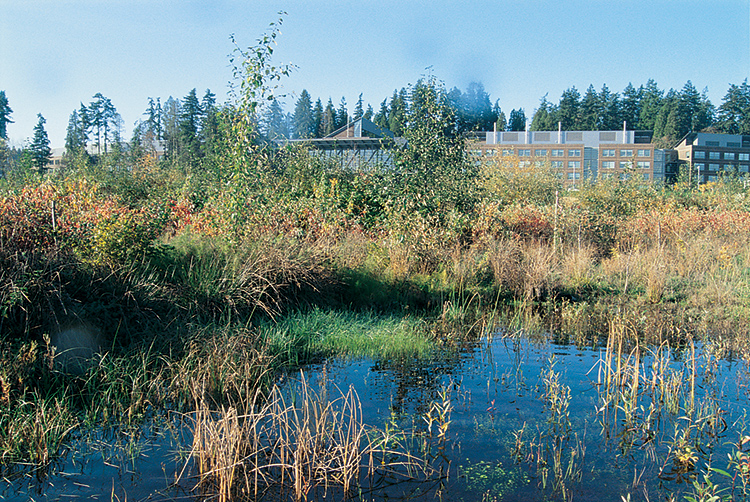
Small ponds or microdepressions built into the wetland act as natural filters for water that drains from higher elevations. Photo by Kathy Sauber.
“People want into the wetlands,” laments Lyndon C. Lee, ‘83, a wetlands ecologist and president of L.C. Lee & Associates, a Seattle firm that is overseeing the project. “They love it to death. We want to keep it intact. Otherwise, we will be destroying it and turning it into a killing zone for many of the animals who have returned.”
While access to the wetlands is heavily restricted, the marshlands are so wild and beautiful these days that people are itching to get in.
For instance, there was the time a well-meaning Eagle Scout wanted to help solve a vexing problem plaguing one particular building at UW Bothell — the nesting of more than 200 cliff swallows in the underside of the metal roof of the North Creek Café. The birds’ presence has resulted in a massive problem with excrement covering many of the café’s support poles, not to mention handrails and even the café balcony.
The scout placed dozens of pine birdhouses on trees throughout the wetlands — a well-intentioned effort that turned out to be a waste of time because swallows won’t live in birdhouses. They prefer something like an outbuilding, wetlands biologists say. (The problem of the swallows has yet to be resolved.)
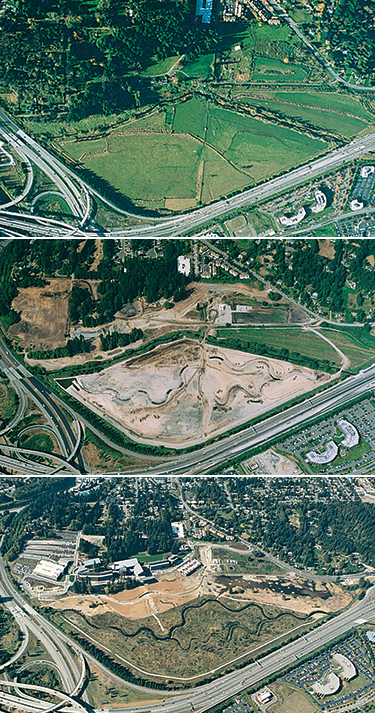
At top, a 1997 aerial view shows the Richard Truly Farm in Bothell that would become home to UW Bothell and Cascadia Community College. The cow pasture at the bottom would be turned into wetlands. At center, a 1998 aerial view documents the extensive work that has begun on the former farmland. At bottom, a 2001 aerial view shows the transformation of the pasture into wetlands. Note the new meandering stream that crosses the 58 acres.
There has been talk of building a bus overpass through the wetlands to connect the freeway to campus — something UW Bothell Chancellor Warren Buck says will never happen.
And there is increasing interest to use the wetlands as an outdoor laboratory. Indeed, the potential of having a natural lab at the university’s doorstep has attracted many students and faculty to UW Bothell, and Buck calls the wetlands the “centerpiece” of campus. (Currently, college classes from UWB, Cascadia Community College and other Puget Sound-area colleges use the wetlands for “observational research” — that is, coming in to look at plant and animal communities and conducting such low-impact activities as measuring water and air quality.)
The fact that the wetlands are so healthy right now and have attracted so much interest is a testament to the reclamation project that started in 1998, four years after the state’s Higher Education Coordinating Board selected the land — known as the Truly Farm/Stringtown site — as the home for a new campus of the University of Washington and a new community college.
The site consisted of 127 acres of drained pastureland that was a longtime beef cattle and dairy farm run by Boeing engineer and part-time rancher Richard Truly.
Reclaiming the area has not been easy. “The land was highly degraded,” says Lee. “The plant community was in bad shape by an invasion of Eurasian weeds. The habitat for the fish in the stream was in bad shape. Restoring it to its natural state has been a major undertaking.”
The choice puzzled observers who wondered why the state would pick a parcel that had a wetlands area that could never be developed. Developers who had thoughts of turning the area into a shopping center walked away because of the prohibitive cost of dealing with the wetlands. And one prominent member of the University of Washington Board of Regents was particularly galled, going so far as to call the land “half swamp.”
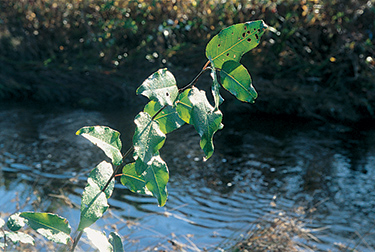 Located at the southernmost tip of the 12 1/2-mile-long North Creek Channel, the wetlands serve a watershed of nearly 30 square miles in Snohomish County. Starting near Everett, North Creek drains into Lake Sammamish, which in turn empties into Lake Washington.
Located at the southernmost tip of the 12 1/2-mile-long North Creek Channel, the wetlands serve a watershed of nearly 30 square miles in Snohomish County. Starting near Everett, North Creek drains into Lake Sammamish, which in turn empties into Lake Washington.
The degradation of the wetlands’ original lush state began in the late 1860s following the arrival of white settlers. England native George Rutter Wilson, who staked a claim there in 1862, logged the timber from his homestead to finance its early development as a farm. In 1880, a log flume was constructed, using water from North Creek, the small river that crossed his property. In constructing the log flume — designed to carry the logs to saw mills along the shore of Lake Washington — North Creek was straightened and ditched, helping drain his low-lying property. He removed tree stumps, graded the land and built a house.
In 1916, he sold his property to Benjamin Ewing Boone, a businessman who wanted to turn it into a duck-hunting club. That same year, the character of the land changed when the opening of the Chittenden Locks in Ballard and the completion of the Montlake Cut resulted in the lowering of Lake Sammamish and Lake Washington by up to 11 feet. That caused the land to become a pastureland, so Boone converted it into a cattle ranch.
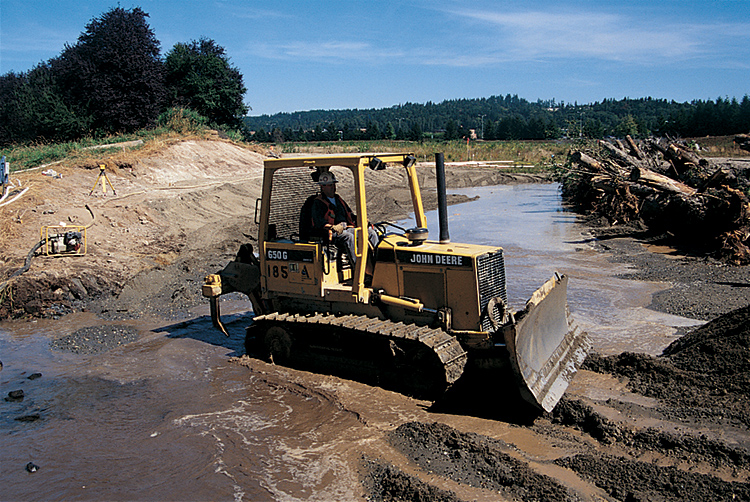
Bulldozers did the bulk of the work in turning the former cattle
ranch into a wetlands.
The land remained a ranch until the early 1990s, when Truly decided to sell.
Once the state settled on the site, it faced some major challenges. The buildings for UW Bothell and Cascadia Community College are built on six acres of sloping wetlands themselves. (In order to mitigate that impact under the Clean Water Act, the lowland restoration was undertaken.)
“Our task was to figure out what to do with it,” explains Lee. “It took 80 years for the area to be changed from a forest into a pasture. We would just be setting things in motion. You can’t change it back in one or two years. It will take a long time.”

Workers undertake the painstaking task of removing invasive weeds and checking that native plants are
now taking root in the wetlands.
Bulldozers and earthmovers graded the site, removing invasive weeds in the process and then cutting new meandering channels. Then, ecologists added floodplain features such as small hills and ditches.
The grading took more than a year as contractors reconnected the creek to its flood plain by reconstructing a meandering channel system that would provide natural hiding and feeding places for fish and other animals. Once that was done, workers dug small ponds called microdepressions to act as natural filters for water that drained from higher elevations. This would siphon off energy released by rushing waters during heavy rains and add a natural filtering system to remove silt and other contaminants from the water. Theyalso added features such as small hilly areas to serve deer and other wildlife.
Once the area was free of invasive reed canary grass, Himalayan blackberry and purple loosestrife, workers planted native vegetation such as Douglas fir, red cedar and other trees (much of it grown at a nursery on the wetlands site). By the turn of the century, these baby trees will grow into a thick forest. That should kill off the pesky reed canary grass with a canopy of shade, while providing a natural barrier between the land and the freeway.
A 10-year monitoring project began in spring 2002 to make sure the area meets city, county, state and federal water and air quality standards, and that the non-native weeds are not regaining their footing.
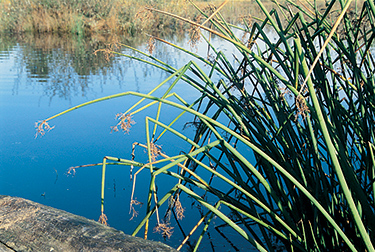 Another measure of progress is the number of wildlife species returning to the wetlands. Sockeye, Chinook and wild King salmon and steelhead once again make North Creek their home. And the number of bird species spotted has grown significantly. Dozens of species, from the common barn swallow to the rarely seen dark-eyed junco can be found in the wetlands, according to Jennifer Leach, a UW Bothell senior who studies birds.
Another measure of progress is the number of wildlife species returning to the wetlands. Sockeye, Chinook and wild King salmon and steelhead once again make North Creek their home. And the number of bird species spotted has grown significantly. Dozens of species, from the common barn swallow to the rarely seen dark-eyed junco can be found in the wetlands, according to Jennifer Leach, a UW Bothell senior who studies birds.
“Birds are finding their way to the site and using it in varying capacities throughout the year,” she says. “The site seems to be providing wintering habitat for several species, others bred there this year, and still others seem to use the site as a stopping place during their spring or fall migrations.”
Researching how well wetlands transformation works was one of several goals of a 1999 Tools for Transformation grant headed by Warren Gold, a UWB professor of plant ecology and environmental science.
One plan is to make the wetlands into an educational resource by creating a “Walk Through Washington” trail. The idea is to turn the historic Chase House — the home of Dr. Reuben Chase, the first doctor in Bothell, which is on the UWB property — into a research station and interpretive center. A trail would lead out through the tall grasslands of the buffer zone between campus buildings and the wetlands into areas planted with trees and vegetation from different parts of the state.
“We have an unparalleled resource here,” Gold says. “We are fortunate that we have the opportunity here to reclaim this land. This is quite rare for an urbanized area like this one.”
“As the area gets developed,” says Dan Jaffe, a UWB chemistry professor who is part of the Tools for Transformation project and monitors air and water quality in the wetlands, “it puts more challenges on the streams and fish. Snohomish County is becoming an increasingly urbanized area. Can we hang onto the nature we have there and preserve it? That is the challenge.”